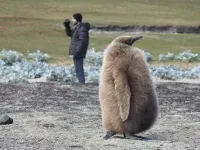Chemists achieve breakthrough in the production of three-dimensional molecular structures
New dimensions in organic chemistry through light-mediated synthesis; publication in 'Science'
2021-03-25
(Press-News.org) A major goal of organic and medicinal chemistry in recent decades has been the rapid synthesis of three-dimensional molecules for the development of new drugs. These drug candidates exhibit a variety of improved properties compared to predominantly flat molecular structures, which are reflected in clinical trials by higher efficacy and success rates. However, they could only be produced at great expense or not at all using previous methods. Chemists led by Prof. Frank Glorius (University of Münster, Germany) and his colleagues Prof. M. Kevin Brown (Indiana University Bloomington) and Prof. Kendall N. Houk (University of California, Los Angeles) have now succeeded in converting several classes of flat nitrogen-containing molecules into the desired three-dimensional structures. Using more than 100 novel examples, they were able to demonstrate the broad applicability of the process. This study will be published by Science on Friday, 26 March 2021.
Light-mediated energy transfer overcomes energy barrier
One of the most efficient methods for synthesizing three-dimensional architectures involves the addition of a molecule to another, known as cycloaddition. In this process, two new bonds and a new ring are formed between the molecules. For aromatic systems - i.e. flat and particularly stable ring compounds - this reaction was not feasible with previous methods. The energy barrier that inhibits such a cycloaddition could not be overcome even with the application of heat. For this reason, the authors of the "Science" article explored the possibility of overcoming this barrier through light-mediated energy transfer.
"The motif of using light energy to build more complex, chemical structures is also found in nature," explains Frank Glorius. "Just as plants use light in photosynthesis to synthesize sugar molecules from the simple building blocks carbon dioxide and water, we use light-mediated energy transfer to produce complex, three-dimensional target molecules from flat basic structures."
New drug candidates for pharmaceutical applications?
The scientists point to the "enormous possibilities" of the method. The novel, unconventional structural motifs presented by the team in the "Science" paper will significantly expand the range of molecules that medicinal chemists can consider in their search for new drugs: for example, basic building blocks containing nitrogen and highly relevant to pharmaceuticals, such as quinolines, isoquinolines and quinazolines, which have been scarcely used owing to selectivity and reactivity problems. Through light-mediated energy transfer, they can now be coupled with a wide range of structurally diverse alkenes to obtain novel three-dimensional drug candidates or their backbones. The chemists also demonstrated a variety of innovative transformations for the further processing of these synthesized backbones, using their expertise to pave the way for pharmaceutical applications. The method's great practicality and the availability of the required starting materials are crucial for the future use of the technology: the molecules used are commercially available at low cost or easy to produce.
"We hope that this discovery will provide new impetus in the development of novel medical agents and will also be applied and further investigated in an interdisciplinary manner," explains Jiajia Ma. Kevin Brown adds: "Our scientific breakthrough can also gain great significance in the discovery of crop protection agents and beyond."
Synergy of experimental and computational chemistry
Another special feature of the study: the scientists clarified the reaction mechanism and the exact structure of the molecules produced for the first time not only analytically and experimentally in detail, but also via "computational chemistry": Kendall Houk and Shuming Chen conducted detailed computer-aided modeling of the reaction. They were able to show how these reactions work and why they occur very selectively. "This study is a prime example of the synergy of experimental and computational theoretical chemistry," emphasizes Shuming Chen, now a professor at Oberlin College in Ohio. "Our detailed mechanistic elucidation and understanding of reactivity concepts will enable scientists to develop complementary methods and to use what we learned to design more efficient synthetic routes in the future," adds Kendall Houk.
The story behind the publication
Using the method of light-mediated energy transfer, both Jiajia Ma/Frank Glorius (University of Münster) and Renyu Guo/Kevin Brown (Indiana University) had success, independently. Through collaborations with Kendall Houk and Shuming Chen at UCLA, both research groups learned of the mutual discovery. The three groups decided to develop their findings further together in order to share their breakthrough with the scientific community as soon as possible and to provide medicinal chemists with this technology to develop novel drugs.
INFORMATION:
[Attachments] See images for this press release:

ELSE PRESS RELEASES FROM THIS DATE:
2021-03-25
Skoltech scientists and their colleagues have proposed a new human height inheritance model that accounts for the interaction between various factors that influence adult human height. The research was published in the European Journal of Human Genetics.
Human height is a classical quantitative trait that depends on sex, genetics, and the environment.
Scientists from Skoltech, Novosibirsk State University, the Institute of Cytology and Genetics of the Siberian Branch of RAS, and the Institute of Science and Technology in Vienna analyzed the human height distribution ...
2021-03-25
Buried beneath 20 kilometers of ice, the subsurface ocean of Enceladus--one of Saturn's moons--appears to be churning with currents akin to those on Earth.
The theory, derived from the shape of Enceladus's ice shell, challenges the current thinking that the moon's global ocean is homogenous, apart from some vertical mixing driven by the warmth of the moon's core.
Enceladus, a tiny frozen ball about 500 kilometers in diameter (about 1/7th the diameter of Earth's moon), is the sixth largest moon of Saturn. Despite its small size, Enceladus attracted the ...
2021-03-25
About two decades after first devising a new kind of vaccine, Oregon Health & Science University researchers are unlocking why it stops and ultimately clears the monkey form of HIV, called SIV, in about half of nonhuman primates - and why it's a promising candidate to stop HIV in people.
In scientific papers that were simultaneously published today in the journals Science and Science Immunology, creators of the cytomegalovirus, or CMV, vaccine platform describe the unusual biological mechanisms through which it works.
The findings also helped fine-tune VIR-1111, the CMV-based experimental vaccine against HIV that was developed at OHSU and is now being evaluated in a Phase 1 clinical trial. The trial is being conducted by Vir Biotechnology, which ...
2021-03-25
SILVER SPRING, Md. - As concern has grown over COVID-19 variants and their implications for how well COVID-19 vaccines will protect against the virus, researchers have proposed a method to examine instances of SARS-COV-2 infections in people who have received a COVID-19 vaccine.
Genomic sieve analysis of these so-called "breakthrough" SARS-CoV-2 infections in COVID vaccine trials is a critical tool to identify viral mutations associated with vaccine failure and to predict how vaccination impacts the virus' evolution.
Dr. Morgane Rolland, Chief of Viral Genetics ...
2021-03-25
Scientists at Sinai Health say they have discovered a new pathway that controls dangerous overreactions in a body's immune system, including deadly forms of hyper-inflammation.
In new findings out today in the journal Science, researchers at the Lunenfeld-Tanenbaum Research Institute (LTRI) detail how a protein known as WAVE2, a protein expressed in all immune cells, plays a critical role in maintaining immune system balance.
As part of the research, scientists knocked out, or turned off, WAVE2 in a subset of immune cells in mice, which led to severe autoimmunity and inflammation, ...
2021-03-25
Despite having remarkable utility in treating movement disorders such as Parkinson's disease, deep brain stimulation (DBS) has confounded researchers, with a general lack of understanding of why it works at some frequencies and does not at others. Now a University of Houston biomedical engineer is presenting evidence in Nature Communications Biology that electrical stimulation of the brain at higher frequencies (>100Hz) induces resonating waveforms which can successfully recalibrate dysfunctional circuits causing movement symptoms.
"We investigated the modulations in local ?eld potentials induced by electrical stimulation of the subthalamic nucleus (STN) at therapeutic ...
2021-03-25
Tel-Aviv, ISRAEL - March 25, 2021 - Wild Biotech, a preclinical stage drug discovery & development company emerging out of stealth mode, today announces the publication of its first major paper, which appears in the journal Science. The study mapped the gut microbiota of animals in the wild on an unprecedented scale, adding millions of potentially novel microbiome-based therapeutics for human diseases to the company's already massive database. Wild will use these findings to first tap its database for targets in inflammatory, immune and gastrointestinal diseases.
"For the study, we collected gut microbiota from almost 200 species of animals in the wild, covering diverse classes, feeding behaviors, geographies, and ...
2021-03-25
Water scarcity in rural Alaska is not a new problem, but the situation is getting worse with climate change. Lasting solutions must encourage the use of alternative water supplies like rainwater catchment and grey water recycling. They must also address the affordability of water related to household income, say researchers from McGill University.
Washing hands with clean water is something most people take for granted, yet for Alaska's rural residents, this is often not the case. When people pay for water by the gallon, serious thought is given to how much is used - even during the COVID-19 pandemic.
In many rural Alaskan communities, where jobs are scarce and household income is low, the cost of water is a high burden, according to the study published in Environmental ...
2021-03-25
A medical device that has been shown to manage pain among babies born preterm can also help keep their brain oxygen levels steady during medical procedures, finds new analysis by researchers at UBC.
The device, called Calmer, is a pillow-sized therapeutic bed covered in soft fabric and inserted into the incubator. It can be programmed to mimic a parent's heartbeat and breathing rate-- providing a soothing presence by moving up and down gently to simulate a breathing motion and heartbeat sound for the baby when their parent cannot be present.
"For newborns and particularly for preterm babies, it's critical to keep overall blood oxygen levels steady, especially in the brain. The more stable their brain oxygenation is, the better for their brain development," ...
2021-03-25
Researchers at the Georgia Institute of Technology have uncovered an innovative way to tap into the over-capacity of 5G networks, turning them into "a wireless power grid" for powering Internet of Things (IoT) devices that today need batteries to operate.
The Georgia Tech inventors have developed a flexible Rotman lens-based rectifying antenna (rectenna) system capable, for the first time, of millimeter-wave harvesting in the 28-GHz band. (The Rotman lens is key for beamforming networks and is frequently used in radar surveillance systems to see targets in multiple directions without physically moving the antenna system.)
But to harvest enough power to supply low-power devices at long ranges, large aperture antennas are required. The problem with ...
LAST 30 PRESS RELEASES:
[Press-News.org] Chemists achieve breakthrough in the production of three-dimensional molecular structures
New dimensions in organic chemistry through light-mediated synthesis; publication in 'Science'





